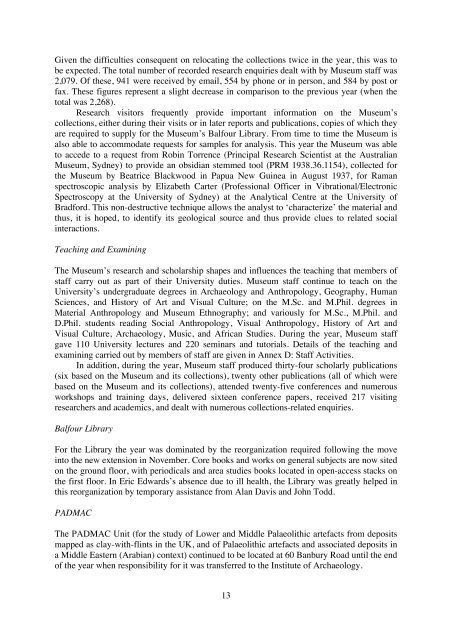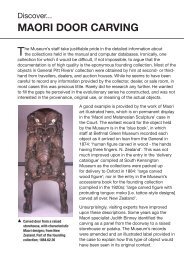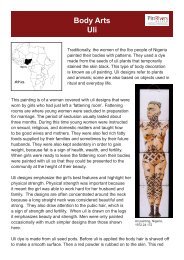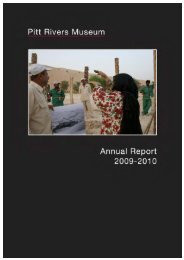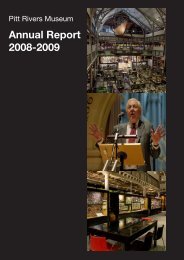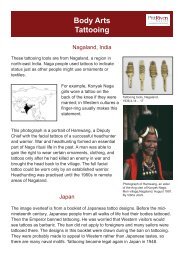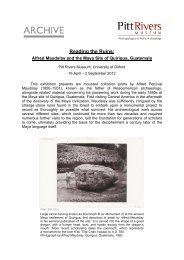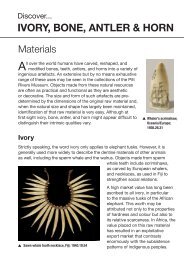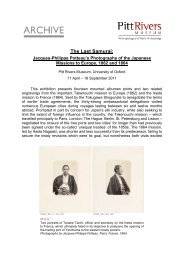Pitt Rivers Museum - University of Oxford
Pitt Rivers Museum - University of Oxford
Pitt Rivers Museum - University of Oxford
You also want an ePaper? Increase the reach of your titles
YUMPU automatically turns print PDFs into web optimized ePapers that Google loves.
Given the difficulties consequent on relocating the collections twice in the year, this was to<br />
be expected. The total number <strong>of</strong> recorded research enquiries dealt with by <strong>Museum</strong> staff was<br />
2,079. Of these, 941 were received by email, 554 by phone or in person, and 584 by post or<br />
fax. These figures represent a slight decrease in comparison to the previous year (when the<br />
total was 2,268).<br />
Research visitors frequently provide important information on the <strong>Museum</strong>’s<br />
collections, either during their visits or in later reports and publications, copies <strong>of</strong> which they<br />
are required to supply for the <strong>Museum</strong>’s Balfour Library. From time to time the <strong>Museum</strong> is<br />
also able to accommodate requests for samples for analysis. This year the <strong>Museum</strong> was able<br />
to accede to a request from Robin Torrence (Principal Research Scientist at the Australian<br />
<strong>Museum</strong>, Sydney) to provide an obsidian stemmed tool (PRM 1938.36.1154), collected for<br />
the <strong>Museum</strong> by Beatrice Blackwood in Papua New Guinea in August 1937, for Raman<br />
spectroscopic analysis by Elizabeth Carter (Pr<strong>of</strong>essional Officer in Vibrational/Electronic<br />
Spectroscopy at the <strong>University</strong> <strong>of</strong> Sydney) at the Analytical Centre at the <strong>University</strong> <strong>of</strong><br />
Bradford. This non-destructive technique allows the analyst to ‘characterize’ the material and<br />
thus, it is hoped, to identify its geological source and thus provide clues to related social<br />
interactions.<br />
Teaching and Examining<br />
The <strong>Museum</strong>’s research and scholarship shapes and influences the teaching that members <strong>of</strong><br />
staff carry out as part <strong>of</strong> their <strong>University</strong> duties. <strong>Museum</strong> staff continue to teach on the<br />
<strong>University</strong>’s undergraduate degrees in Archaeology and Anthropology, Geography, Human<br />
Sciences, and History <strong>of</strong> Art and Visual Culture; on the M.Sc. and M.Phil. degrees in<br />
Material Anthropology and <strong>Museum</strong> Ethnography; and variously for M.Sc., M.Phil. and<br />
D.Phil. students reading Social Anthropology, Visual Anthropology, History <strong>of</strong> Art and<br />
Visual Culture, Archaeology, Music, and African Studies. During the year, <strong>Museum</strong> staff<br />
gave 110 <strong>University</strong> lectures and 220 seminars and tutorials. Details <strong>of</strong> the teaching and<br />
examining carried out by members <strong>of</strong> staff are given in Annex D: Staff Activities.<br />
In addition, during the year, <strong>Museum</strong> staff produced thirty-four scholarly publications<br />
(six based on the <strong>Museum</strong> and its collections), twenty other publications (all <strong>of</strong> which were<br />
based on the <strong>Museum</strong> and its collections), attended twenty-five conferences and numerous<br />
workshops and training days, delivered sixteen conference papers, received 217 visiting<br />
researchers and academics, and dealt with numerous collections-related enquiries.<br />
Balfour Library<br />
For the Library the year was dominated by the reorganization required following the move<br />
into the new extension in November. Core books and works on general subjects are now sited<br />
on the ground floor, with periodicals and area studies books located in open-access stacks on<br />
the first floor. In Eric Edwards’s absence due to ill health, the Library was greatly helped in<br />
this reorganization by temporary assistance from Alan Davis and John Todd.<br />
PADMAC<br />
The PADMAC Unit (for the study <strong>of</strong> Lower and Middle Palaeolithic artefacts from deposits<br />
mapped as clay-with-flints in the UK, and <strong>of</strong> Palaeolithic artefacts and associated deposits in<br />
a Middle Eastern (Arabian) context) continued to be located at 60 Banbury Road until the end<br />
<strong>of</strong> the year when responsibility for it was transferred to the Institute <strong>of</strong> Archaeology.<br />
13


